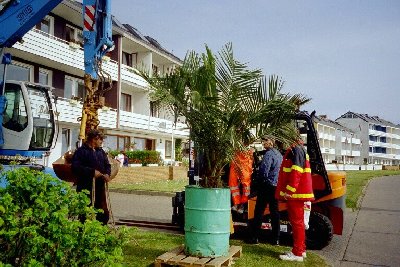
Outplantations 2004 And Jubaea Premiere On Heligoland
After we brought our second site survey with Joerg Witticke in January 2004 with the conversations and negotiations and the Helgoländer Runde (Heligolandian Forum) behind us, we got from several sponsors and donators suitable plants. I had bought even more plants to this so that about 230 plants came in over 110 species, varieties and origins together. The building company HC Hagemann agreed as a sponsor to store our plants on the making court in Hamburg-Harburg. Fortunately I had a professionally favorable constellation to be able to check and look after the plants. So I could go 2 times weekly to HC Hagemann to check. The bananas were taken partly to a leading engineer of HC Hagemann to his office to the storage and the donators partly sent material directly to Heligoland. So the plants came together more and more during the 2 months, only a few losses only had to be mourned, thank the good support by the employees of HC Hagemann and me. We also got 25 bamboos together and also more than 30 palms, we got the four tallest ones donated by Tobias Spanner. The four biggest palms of Tobias Spanner are three nearly 6 feet tall Trachycarpus wagnerianus and one 7 feet tall Jubaea chilensis. The four palms came to HC Hagemann with a forwarding agency only at the beginning of May.
On May 12th I arrived already at 6.30 a. m. at HC Hagemann and met Chris Stuehrk. We both loaded the plants into a blue container of the company HC Hagemann with the aid of some employees. The bananas which were stored in the engineering office, were in good condition thanks to the good support by the engineer and also had sprouted several new leaves. The big Jubaea chilensis could just be taken into the container, because of her size it was quite scarce. The work went on speedily so that we were already ready toward 9.00 a. m. The container was loaded on a truck and driven to Cuxhaven, where it was loaded onto a freighter and was shipped to Heligoland on May 14th. The plants came to the short-term storage to the Karl Meyer (island disposal).On the following day, the May 15th, Matthias Hund fetched us. We went by car to Buesum and a NDR reporter Mrs. Thoma expected us there. We went by ship "MS ATLANTIS". We arrived in Heligoland at 12.00 a. m. and were also very lucky to find accommodation in the hotel "Atoll", the hotel also supports our project. We liked the rooms in the hotel "Atoll" fitted out futuristically very much.
We could fetch our plants for the James Kruess School from Karl Meyer but these were so many plants so that 2 cargo loads were necessary. The first cargo load still was on the same day and the second only on the day following on this. A little electric truck of HC Hagemann took the plants and me to James Kruess School on the Upper Land. Chris, Matthias and my wife followed on foot. Ulf Martens was there and received the plants and me. Ulf and I unloaded the plants on the school playground, before the others came. We took the plants to the corridor to the atria. The 4 atria of the school are relatively large, at first we have distributed the plants on the 3 of the 4 atria, with the planting plans. However, not all could be realized on the planting plans, even more plants arrived there. Originally we wanted to plant each one Jubaea chilensis at the entrance to the school playground on the two sides. However, Ulf and we got doubts because of the possible theft and vandalism danger. We also wanted to plant bamboo at the embankment at the school playground and at the limit walls originally, but had to notice that there it is too windy and also many kids are playing there. Bananas were planted into 2 atria. It was not quite easy to dig planting holes, since the loamy topsoil layer is only approx. 1/3 to 1/2 foot thick, under this a stone layer of red Heligolandian federation sand stone. We had to dig the holes therefore also with the help of the pickaxe. We got much support by pupils and volunteers who strongly supported us, so that the whole went speedily over the stage. Without their terrific support we would hardly have got ready. There were pupils, Chris and Ulf interviewed by Mrs. Thoma of the NDR broadcast, Mrs. Thoma accompanied us from the beginning.
We arranged an appointment with Ulf Martens and Tim Pyschny for the morning of the day following to pick up bamboo and further "exotics" from Karl Meyer. The next day we met them at Karl Meyer and loaded the 2nd cargo load and let to transport them by electric truck from HC Hagemann to school. Bamboo was distributed on all atria, these were 19 plants. Mr. and Mrs. Rickmers of the hotel "Insulaner" and Mr. Cantauw of the hotel "Atoll" got each 3 bamboos later. We spontaneously also decided in favor of the planting of the embankment of the half atrium with 5 bamboos without rhizome block, there bamboo woods shall arise if the bamboo does establish. I selected the locations of the 5 bamboos on the embankment and let to plant them by the pupils. Also the planting island on the school playground I planted with the aid of Ulf, Mathias and Chris new, one Quercus suber, one Pittosporum tobira and two Viburnum tinus were planted out.
In the evening, as we had mostly finished with the outplantations in James Kruess School, my wife and I changed from the hotel "Atoll" to the hotel "Insulaner". We got a beautiful room also there which we also liked. The next day, it was already May 17th, we met Mrs. Rickmers and went with her to Karl Meyer. She was impressed particularly by the large Jubaea. We loaded the plants meant for the garden of the hotel "Insulaner" on the electric truck of HC Hagemann and divided the remaining plants up for the Mielck House, the library and the hotel "Atoll". The plants were then taken to the hotel "Insulaner" and at first we put them onto the lawn of the hotel garden.
I gave Ruth Hartmann who works in the library one Musa acuminata 'Dwarf Cavendish'.
We went to Karl Meyer again and loaded the plants for the hotel "Atoll" and the Mielck House. Chris had already asked Mr. Knoll for an approval and got it. Mrs. Dr. Wiltshire was there and looked at the plants. We carried the plants into the inner courtyard to the empty bed. I cleared the unkempt potato roses (Rosa rugosa) and the roots were carefully removed since potato roses tend to the sucker formation. The soil had to be treated easily, it was sandy soil, ideal for cacti! We then planted a Chamaerops humilis, two Opuntia santa-rita, an unknown opuntia from Joerg Witticke, a small Olea europaea, one Nerium oleander 'Atlas', a Yucca aloifolia and three Delosperma cooperi out.
After this we went back to the hotel "Insulaner" where we met Joerg. Unfortunately, Matthias had to earlier depart again since his uncle had an accident. Also the NDR television team arrived and accompanied us. We also met the Heligolandian cure director Mr. Lackner and the director of the hotel "Atoll" Mr. Cantauw at the hotel "Atoll", where they also were interviewed by the NDR television team. We held a conversation with them. One has suggested us to plant one for three for large Trachycarpus wagnerianus at the entrance of the swimming pool out where we also agreed. The suggestion of Joerg to plant an unexploited corner at the glassy elevator tower with Chamaerops humilis, Nerium oleander and a Trachycarpus wagnerianus was also accepted by Mr. Cantauw. He wanted also bamboo. The Rickmers also wanted to have the large Jubaea for their entrance area. So we had the words deeds followed.
We went with Joerg to James Kruess School once again to carry out some improvements in and completions of the plantations together with Joeg. Joerg also consulted Ulf about rhizome block of bamboo which Ulf and the pupils had planted to the pond edge in one of the atria. Since locks were but not available, suckers must be dug up. Phyllostachys is sucker driving strongly and needs a rhizome lock if it shall be planted at the pond. I always recommend Fargesia as a pond edge planting since this bamboo genre doesn't form any suckers and forms only groves.
The next day was the premiere for Jubaea chilensis on Heligoland! The NDR television team accompanied us again. We were went to Karl Meyer to fetch the big palms. The three large trachies were loaded onto the electric truck of HC Hagemann, they were taken to the hotel "Atoll", to the swimming pool and to James Kruess School. Joerg and I moved the large Jubaea to the middle of the pallet on which it stood. A fork truck was called and brought the Jubaea to the lawn of the entrance area of the hotel "Insulaner". An excavator of HC Hagemann was also there and dug a big planting hole for the Jubaea in the middle of the lawn. The Jubaea was in a big clapped-out green oil barrel with discount holes, obviously palms are grown and delivered in Chile in carefully cleaned oil barrels with discount holes. Joerg tied the Jubaea to the excavator tightly and the excavator raised the Jubaea, then Joerg tried to knock the barrel loosely with a crowbar to then get rid of it from the root bale of the Jubaea. Unfortunately, didn't turn this, the barrel sat too tightly. So a metal blade device was obtained and the barrel was cut open so that the root bale was freed. Then excavator heaved the Jubaea to the planting hole. Joerg, Chris and I shoveled the hole and stepped the soil tightly and watered the palm strongly, then the tied feather leaves were untied again.

The Jubaea still stands in the barrel in which it was grown.
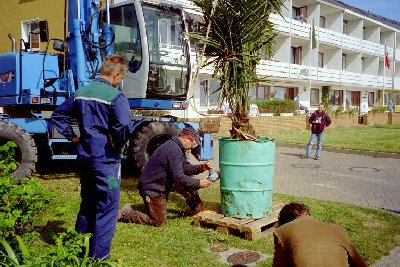
The root bale is carefully cutten out of the barrel.

Now the root bale of the Jubaea is free!
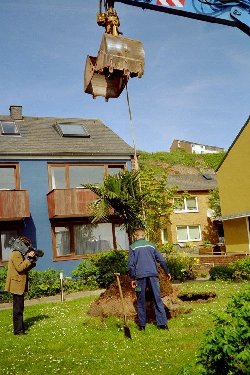
The Jubaea is heaved by the excavator to the
prepared planting hole.
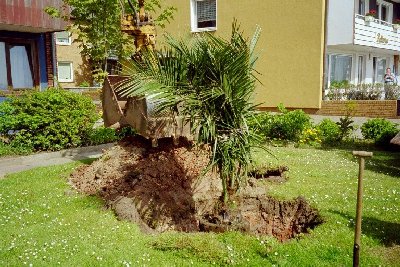
The excavator closes the planting hole.
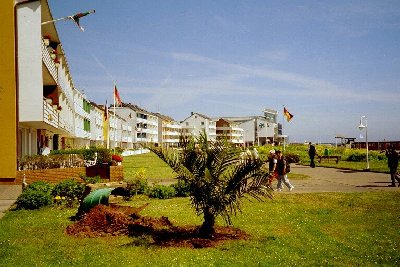
After the closing of the planting hole, stepping tightly and watering the
ready outplanted Jubaea.
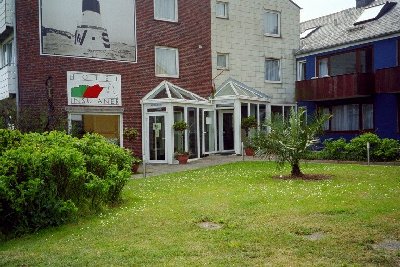
Die Jubaea on the lawn in the front of the entrance of the hotel "Insulaner"
one day after planting.
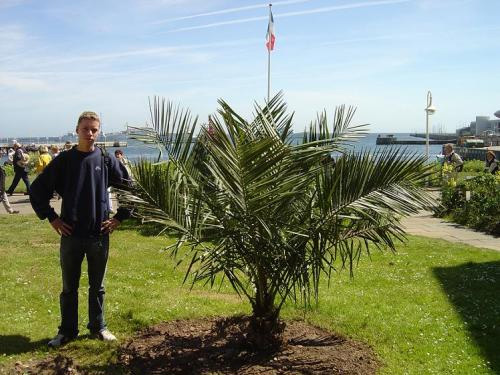
A young "exotic" friend and tourist with the Jubaea of the hotel "Insulaner"
Then we went to the hotel "Atoll" and planted one of the three large trachies together with two Chamaerops humilis and two Nerium oleander out. I also planted Phyllostachys boryana and bissettii to two pillars at the hotel "Atoll" out. Joerg planted a Washingtonia filifera and a Pleioblastus simonii nearby the after-entrance of the hotel.
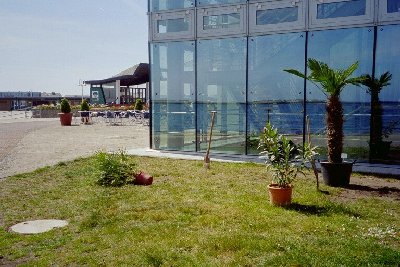
Chamaerops humilis, Nerium oleander and Trachycarpus wagnerianus before
outplanting at the elevator tower of the hotel "Atoll"
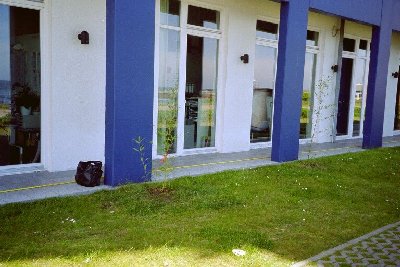
Phyllostachys bissettii and boryana at two of the pilars at the hotel "Atoll".
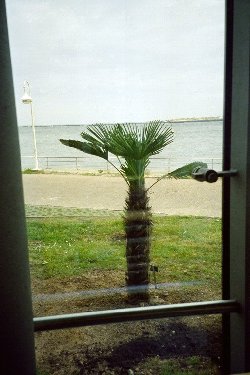
Trachycarpus wagnerianus seen from the inside
of the elevator town of the hotel "Atoll".
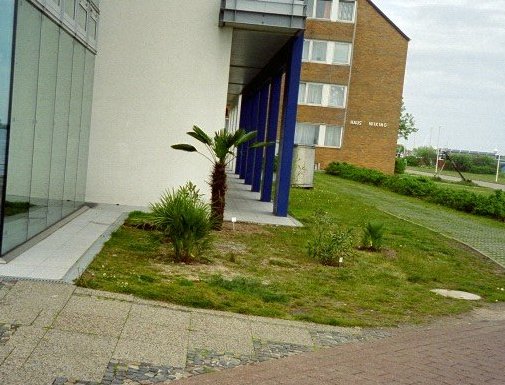
The ready outplanted group of the Trachycarpus wagnerianus, Chamaerops humilis and Nerium
oleander at the hotel "Atoll".
When we had finished with the plantations there, we moved to the swimming pool, there the second of the three trachies stood and waited for us. We got in touch with the director of the swimming pool Mr. Rauch and he suggested a location at the entrance of the swimming pool hall at the wheelchair ramp. Therefore said and worked! Joerg dug a planting hole and planted the trachy.
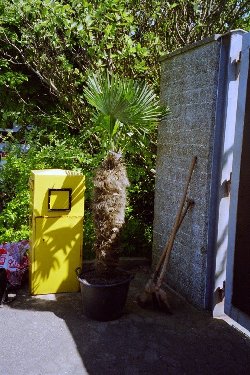
Trachycarpus wagnerianus before the outplanting
at the swimming pool.
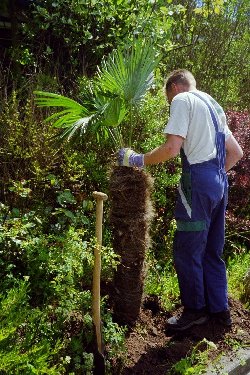
Joerg is planting the Trachycarpus wagnerianus.
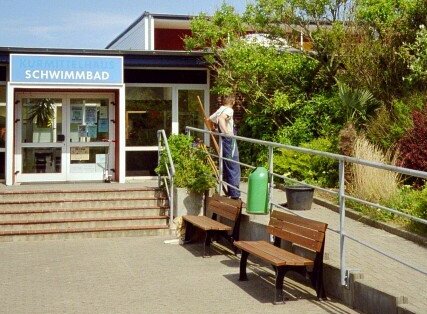
The Trachycarpus wagnerianus stands now ready outplanted at the elevator ramp
at the entrance of the swimming pool hall.
Then we went to the Mielck House, I had a large Cylindropuntia imbricata for it, I planted it on the newly planted bed in the inner courtyard out. Dr. Wiltshire was also there again and wanted to get three of six Trachycarpus fortunei of the group at the entrance of the Mieck House in the corner transplanted. Therefore here said and worked again! Dr. Wiltshire agreed to give one to the trachies to the James Kruess School and Ulf also was called. Joerg dug up the three trachies, he planted one to another wall of the Mielck House again. I watered it strongly. The second of the three dug up trachies Joerg replanted into the inner courtyard on the bed of the berry of the whitebeam, I cut the potato roses there. Ulf came with a handcart and loaded the third trachy gratefully. We went with Ulf and the trachy from the Mielck House to the Upper Land to James Kruess School. Then the Trachycarpus fortunei from the Mielck House was planted again besides the third large Trachycarpus wagnerianus in one atrium of the school.
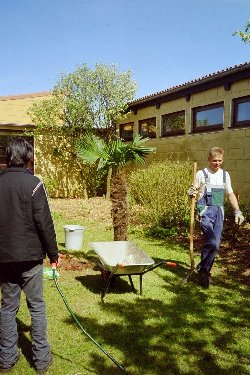
The third Trachycarpus wagnerianus shortly before
planting in one atrium of James Kruess School.
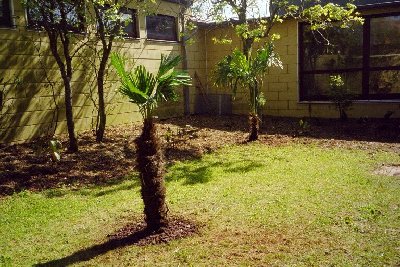
In the foreground the ready planted Trachycarpus wagnerianus and right
in the background the transplanted Trachycarpus fortunei from the Mielck
House in one atrium of James Kruess School.
And I still planted Musa basjoo 'Salmon', Musa sp. Yunnan, Musa sikkimensis and Musella lasiocarpa in the second atrium out. Joerg planted three Jubaea chilensis in an atrium and in another one further out. The new planting of the atria was completed now. We went to the hotel "Insulaner" again and prepared the outplantations in the hotel garden and distributed the plants on different locations in the garden.
The next morning, it was the day of the departure, we still have carried out outplantations in the hotel garden of the "Insulaner". I planted a Musa basjoo 'Sapporo' on the bed on the terrace in the corner of the winter garden. I also could plant still one Eriobotrya japonica out. But I had problems to dig one planting hole for a Pinus canariensis, the ground was stony, structured similarly as the in the atria of the school. Therefore Joerg made the rest. I watered the recently planted "exotics". And cut the locations for the cypresses with my tree pruning shears free, many places of the garden are overgrown with creeping cotoneaster. So that Chris could plant them out.
Also two small Jubaea chilensis were planted out, now the Rickmers have three Jubaeas, one large and two small. Added to them a Butia capitata. And two Chamaerops humilis and a Chamaerops humilis var. cerifera. But they didn't want some pines and a Jubaea anymore since the garden was full now. The three Quercus virginiana they wanted not anymore, too. Therefore the remaining plants went to the James Kruess School. We took the plants to James Kruess School. The plan to put Jubaeas at the entrance to the school playground was realized anyway, but also only with the half. One Jubaea on the left side and the three pines (Pinus pinea, halepensis and canariensis) on the right. To this the Quercus virginiana were also planted out, one Quercus virginiana came to test purposes into an atrium which lies in a more sheltered place.
We were honored by the school, even a top table for us is standing at the large Trachycarpus wagnerianus in the middle of an atrium. As a gratitude we also got T-shirts of the James Kruess School. We gave Ulf our addresses, want to stay with him in the contact.
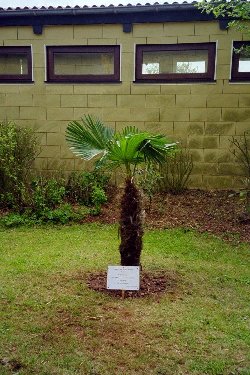
Trachycarpus wagnerianus with top table.
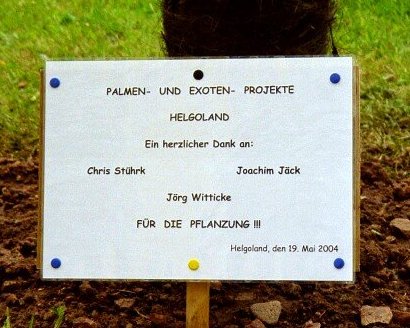
The top table at the Trachycarpus wagnerianus (Translation: Palm And
Exotic Project Heligoland - Many thanks to Chris Stuehrk, Joachim Jaeck
and Joerg Witticke for the planting!!! - Heligoland, May 19th, 2004).
We then went to the hotel "Insulaner" again and got us changed to go to Mr. Lackner. Unfortunately, Mr. Botter had no time for us, for this Mr. Lackner greeted us, he thanked us and we also got presents from him, souvenirs from the island Heligoland.
Finally we took our baggage from the hotel "Insulaner" and went to the port. We boated us in, it was toward 4.10 p. m. The North Sea was a little restless, we had to be careful in boating in. We went by the ship "MS ATLANTIS" to Buesum again where Matthias met us and drove us by car back to Hamburg. Joerg went by the "Wappen von Hamburg" to Cuxhaven.
Some weeks later Dr. Wiltshire told me that the transplated Trachycarpus fortunei in the atrium of the Mielck House was blown over by wind. Obviously the soil there is sandy and loose. The overblown trachy was dug up and taken to James Kruess School where it stands in one atrium now.
Further outplantations are planned for the next years. We will have to go to Heligoland again and again and look after the plants and lead advice conversations. Within the next years eucalyptus trees of different species and further acacias could be planted out, also further hardy palms of many different species. Magnolien also shall be planted, not only the Magnolia grandiflora, but also different magnolia species which aren't rare on the mainland, such as Magnolia kobus, stellata and others, since Joerg and I had noticed that no magnolias are standing on Heligoland. Otherwise we would have already seen them in flower on Heligoland. Perhaps we try even Magnolia campbellii, this is a leaves throwing off magnolia species which is not hardy enough in Germany but thriving in the southern Switzerland and in the U. K.
Photo Gallery About The Outplantations 2004 (unfortunately only in German, please click the link on!)
Author: Joachim Jaeck
Updated June, 5th, 2004